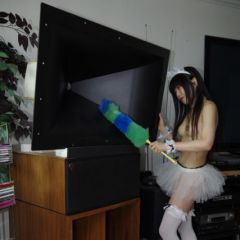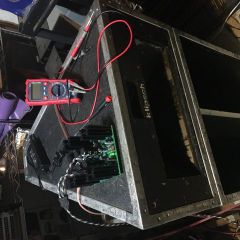-
Posts
9179 -
Joined
-
Last visited
-
Days Won
14
Islander last won the day on May 8 2023
Islander had the most liked content!
Profile Information
-
Gender
Male
-
Location
Vancouver Island, BC, Canada
-
Interests
Audio, Music, Photography
-
My System
402/K-691 JubScala IIs + Paradigm Seismic 110 x 2, powered by Yamaha MX-D1 x 2, EQ'd by Electro-Voice Dx38, controlled by Yamaha RX-A2060, fed by Technics SL-1210M5G, Panasonic DMP-UB900 & Yamaha DVD-S550
6.2 Surround: above plus Belle (centre front), La Scalas (left and right surround), Heresy III (centre rear)
Islander's Achievements

Klipsch Ultra Fanatic (7/9)
3.7k
Reputation
-
You might be able to correct that 'thickening' sensation with some judiciously applied EQ, assuming you can get an equalizer with very clean sound that won't throw a veil over the whole listening range like my 1980s equalizer did. The Electro-Voice Dx38 24-bit audio processor that was used in the development of the UG Jubilee and the JubScala does not have this issue. In the list of settings for that electronic audio processor, that replaces the crossovers in the JubScalas, Roy included a 7 dB cut at 148 Hz. That might be worth looking into for your system. As I've mentioned in other posts, that 148 Hz peak is not due to any kind of resonance, because the setting is the same for both the La Scala II as well as the original La Scala, which has the less stiff 3/4" plywood cabinet material. It's a characteristic of that horn. As to why PWK would continue to build speakers with bass horns that have this characteristic, I surmised that in the compromises that are necessary in the building and voicing of any speaker, he must have decided that this perceived negative characteristic ('perceived' negative, because some owners may like a bit of upper bass boost) was outweighed by a positive somewhere else. Or, PWK may have decided that, as I've seen this expression from him occasionally, "It doesn't make a dime's worth of difference."
-
Really, 1 more makes 5. The only way to beat that hand is with 6 or 7 of them. Of course, a Belle Klipsch would also make a great front centre unit. The BK even makes a slightly better TV stand than a Scala, because it's only 18" deep, unlike the 24" of the La Scalas. Amusingly, Spell Check somehow came up with Skala. Yes, the La Scala plays Ska and Ska-Punk music quite well. On the AV side of ska-punk recordings, No Doubt's ROCK STEADY L*I*V*E DVD rocks really well on La Scalas. That was one of the first DVDs I watched and listened to after I had done the JubScala conversion to my first Scalas. And my socks? Knocked off! Just a bit of enabling, both ways. You're all welcome!
-
16 ft? Wow! Yes, that must be amazing. I have a 65" Panasonic plasma TV, which has a great picture, but sitting abut 12 feet back from it is like sitting at the back row of a big-screen movie house room. I'm single, too, but no women visitors have grumbled about the JubScala IIs, which are the usual washing machine size, plus the big K402 tweeter horns on top don't always register as speakers. More than one visitor has thought that they're inactive TV monitors, and that I have a 3-screen array, since the 402s are almost exactly the same height and width as 40" flat screen TVs. Anyway, the least expensive sound absorbers I've heard of were a DIY arrangement of folded thick towels, that are painted and then framed. You can paint them to match the wall or contrast with it, and of course the thicker the better. That might work better in smaller rooms, though. As for dispersion pattern, the 402s are very directional, since they're a modified Tractrix design, so that from just outside the room, they're not loud, but when you get in front of them, they're much louder. This greatly reduces early side wall reflections, so that's good, but the back wall is still there, with some stuff in front, but a fair area of bare wall. In the New year, I'll be looking into something. Just what, I'm not sure yet. Let us know what TEMU is like to deal with. I've seen some flame-fired teacups from them that look really good, but ordering from some online-only firms can be chancy.
-
Klipsch made many network changes through the history of the original La Scala, A, AA, AL, and so on, and the name of the speaker never changed, Is that what you mean? And by the way, Merry Christmas!
-
Ah, so it's still the AL-5 in the US? The La Scala III name makes more sense to me, since the AL-5 "name" sounds like a factory designation for a prototype, while La Scala III sounds like a fully developed member of the Heritage family. What do you think?
-
Don't set a price and buy accordingly. Instead, decide which receiver you really want, and if you don't have enough money right now, just keep putting some into your Audio Buying Account every payday until it's all there. Then you'll have what you really want in the first place, and can sit back and enjoy your music without any pesky thoughts about the hassle of trading up model by model, losing money every time. Getting the unit you want in the first place means more time listening to better sound. Isn't that the best? That might sound odd, but having a separate account (in your bank, in your sock, under the mattress) for your audio stuff is how you can have the cash to jump on bargains when you spot them, and gives you bargaining power, because cash is always king, unless your cards have a big limit and you can pay off the balance in a month or two. Brand-wise, Onkyo have a name for running hot, which may shorten their life. I've always had good results with Yamaha gear, and I hear good things about Marantz.
-
I happened to take a look at the Klipsch.com site, using the link at the top of the page, and happened to notice that the latest version of the La Scala is now called the La Scala III. To me, this makes sense, and gives it a feeling of continuity with the older La Scalas, as well as harmonizing with the other Heritage Series speakers that are named by their version number. Here it is: https://www.klipsch.ca/collections/heritage/products/klipsch-la-scala-iii-floorstanding-speakers?variant=40025469780103 Since I'm in Canada, I was taken to the Klipsch.ca site, so that may be the price in Canadian dollars. At least there's free shipping to all provinces!
-
Some folks confuse woofer with subwoofer, and think the bass driver in any speaker is called a subwoofer, rather than a woofer. Have we heard any more from the OP?
-
Coytee, you should have put on that Tull LP, then followed it with Boston, at the same volume setting. That would have been a laugh. BTW, did the Jethro Tull LP have more dynamic range than other records? Less compression, so to speak? And which Tull record was it? Stand Up? Or Aqualung?
-
A bookcase is also a good thing to have on the back wall of your listening room, although it works as a diffuser as much as an absorber. Mine's 6' tall by 4' wide, which will have a definite effect. Actually, since my system's evolved as far as I want to take it, the next step is room treatment, but rather than install sound absorbing panels at random locations, I'm considering bringing in a consultant. However, as you put the idea, it makes sense. It won't get done for a while, though, since the Must Get Done list is still too long.
-
General Klipsch Info or 2-Channel Home Audio or maybe Architectural would be more suitable locations. Or maybe Home Theater... Maybe I'm not the best person to ask... Anyway, welcome to the Forum! Or as some others say, Welcome to the Madness!
-

Looking for a good amp for my new Cornwall IV's (Canada)
Islander replied to partymark's topic in 2-Channel Home Audio
It's good that you found an amp that seems to have good synergy with your speakers. That matters so much. My system was steadily upgraded over a 15-year period and I knew it had reached a high level of detail retrieval when I could hear a piano sound like a real instrument, a big wooden object about eight feet in front of me, with fine-sounding strings within the wooden body. Then a friend pointed out that she could tell whether the piano player was facing us or not. If he was facing away, the bass notes came from the left of the soundstage and the treble notes came from the right, and if he was facing us, it would be the other way around. That was another eye/ear opener. Welcome to the Forum, Azzaro! -
In my home, you won't find any wires smaller than 12 gauge, including the living room and bedroom systems. When it comes to the bi-amped LS2s, the woofers get 8 gauge and the tweeters get 10 gauge, both in twisted pair configuration. The 8s were bought before I got La Scalas, when their size made more difference. However, they were still good, so I kept using them. The 10s were a step down and were for the tweeters (which are rated at 50 watts max), so that seemed right. The cables are 15 feet long, which may be a small factor. However, the bigger cables cause minimum loss to the amplifiers' damping factor, as well as minimizing resistance/impedance. And that's all I've got to say.
-
When it comes to that upper bass peak, it seems to be part of the horn's performance. I can only suspect that PWK reasoned that in the compromises that are part of engineering any device, that "loss" was outweighed by a gain somewhere else. Also, since the newer horns (up to and including the LS-5) still sound like that, it looks like Klipsch gets very few complaints about it, other than from the persnickety members of the Forum, who wish that the Heritage speakers were all perfect, just different flavours of perfect, with the bigger ones having bigger performance envelopes. BTW, there is a slight difference in the newer (LS2 on) bass horns. The new ones are about an inch longer, making the cabinets about an inch deeper. This is noticeable in that the point of the Vee of the bass horn is recessed about an inch farther back than the Vee point of the original Scala.
-
Yes, some topics seem to come around and go around. Just don't say that you think that speaker cables bigger than 16 gauge might sound better, lol.






